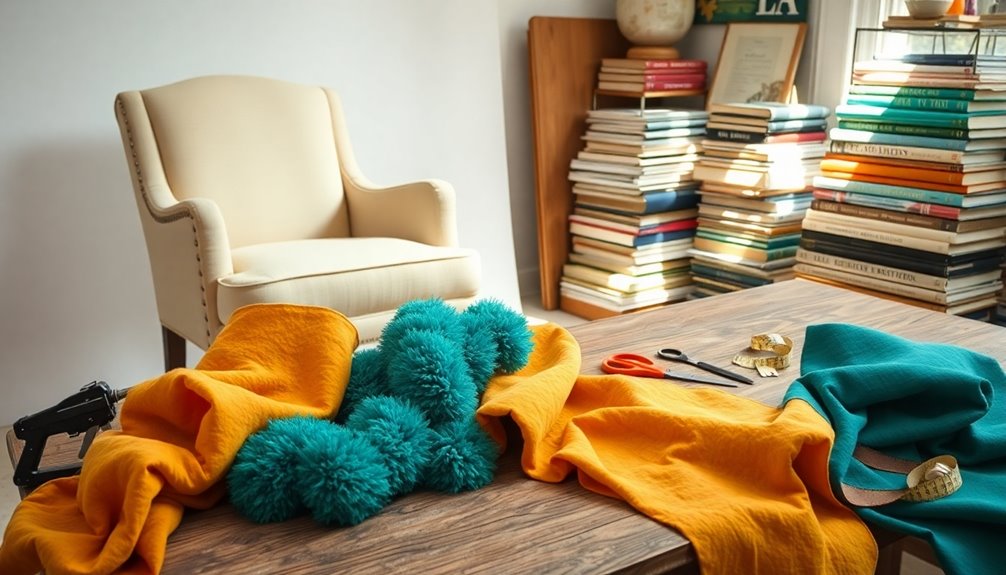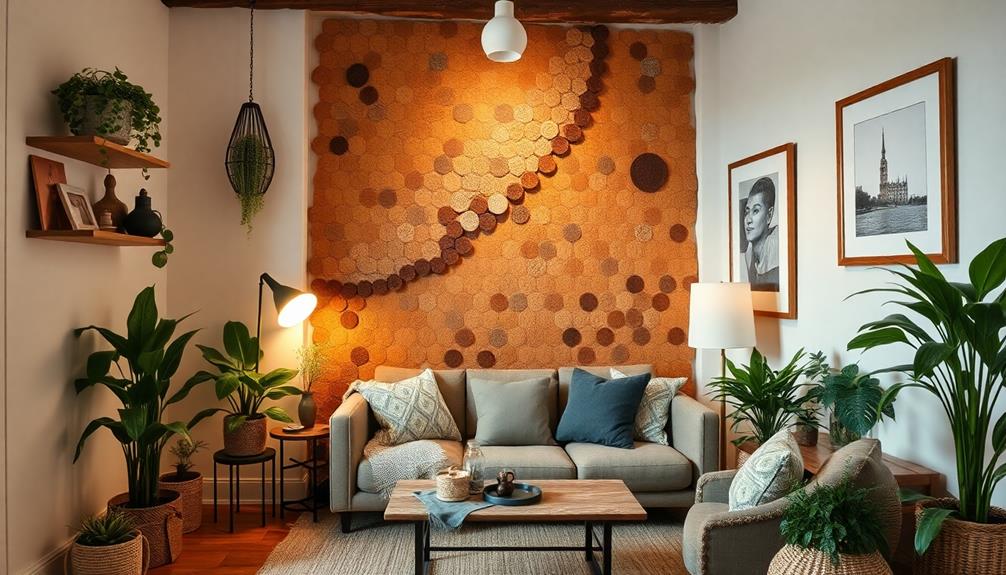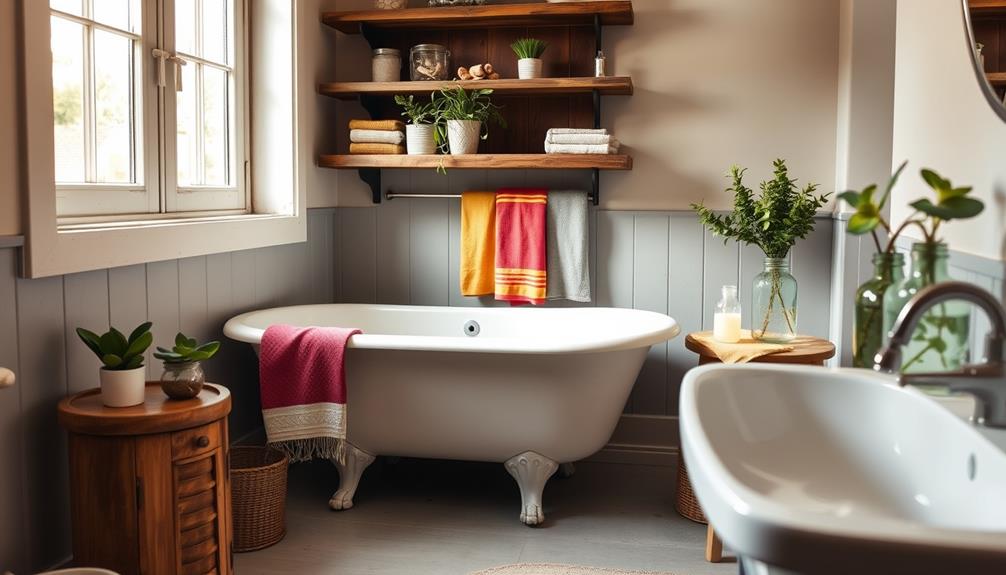To reupholster furniture, start by evaluating its condition and making necessary repairs. Check for structural integrity and reinforce any weak spots. Next, choose a durable fabric that fits your style and the piece's purpose. Measure and cut the fabric accurately, using the old fabric as a pattern. When applying the new fabric, use a staple gun to ensure it's tight and wrinkle-free. Secure corners neatly and consider adding decorative touches like trim or buttons for flair. Finally, inspect your work to ensure everything's tight and tidy. There's plenty more to explore to perfect your skills!
Key Takeaways
- Assess the furniture's emotional and practical value before starting the reupholstering process, ensuring you want to invest time and resources.
- Choose durable fabric suitable for the intended use, considering factors like traffic, comfort, and color to complement your space.
- Carefully measure and cut the fabric, ensuring it is square and labeled, using original fabric pieces as patterns for accuracy.
- Securely attach the new fabric using a staple gun, ensuring it is taut, and replace any worn padding before finishing the upholstery.
- Finish with decorative elements and protective undersides, ensuring a polished look while preserving the furniture's longevity and durability.
Evaluation and Disassembly
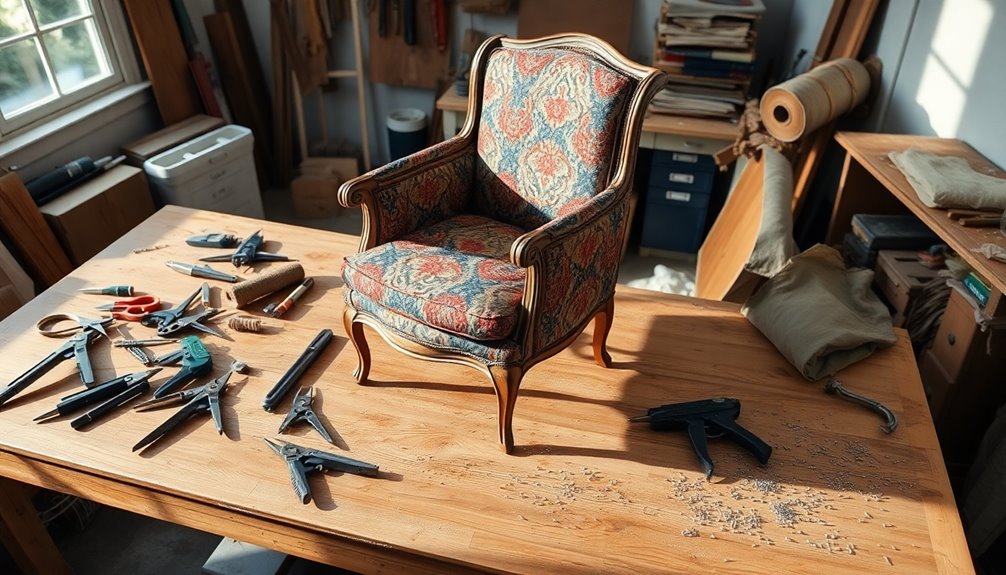
When you're preparing to reupholster furniture, your first step is to evaluate its condition and disassemble it carefully. Start by assessing the emotional and practical value of the piece. Consider factors like comfort, size, and any sentimental attachments you may have. Check the structural integrity by grasping opposing parts to identify any movement or looseness. Inspect exposed wood or metal for necessary cleaning or refinishing. It's crucial to determine if the furniture has solid 'bones'—a sturdy frame—while keeping an eye out for composite-wood substitutes like particle board, which may not be worth restoring. Additionally, it's important to evaluate potential worth to ensure the investment aligns with your expectations.
Next, move on to disassembly. Remove cushions and slipcovers to access the underlying structure. Detach legs and arms by unscrewing them, and use tools like staple removers and pliers to carefully take off old fabric. As you disassemble, label and store each component securely to avoid damage. Document the process with photos and notes to aid reassembly later. Remember to protect delicate surfaces with bubble wrap or thick padding during this stage, ensuring you handle everything with care.
Repairs and Preparation
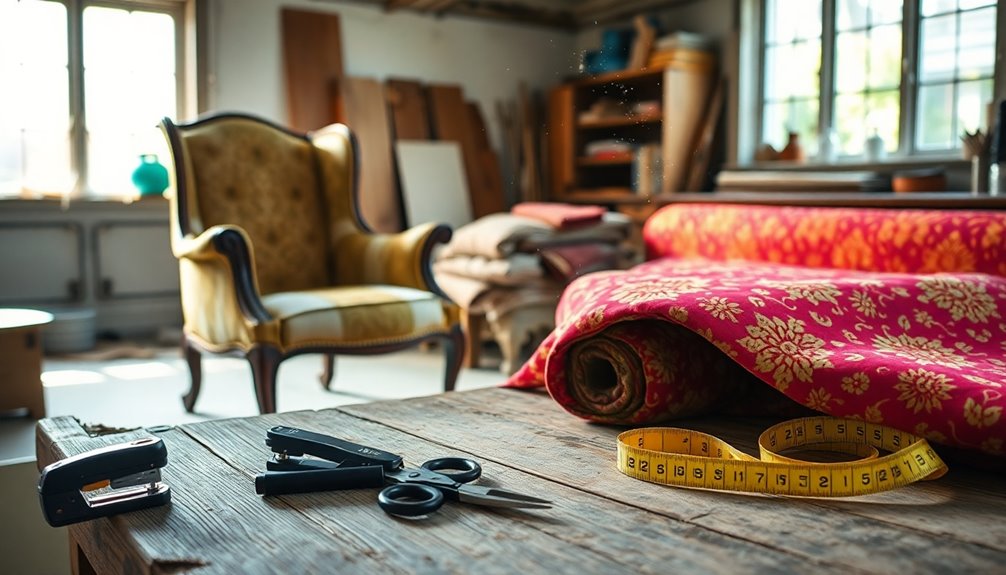
Repairing and preparing your furniture is essential for a successful reupholstering project. Start by inspecting the frame for any damages, like loose joints or broken pieces. If you find weak springs or sagging cushions, reinforce those areas. For wooden frames, use wood filler for any dents or scratches, then sand them smooth, transitioning from medium-grit to fine-grit sandpaper. A clear topcoat will protect your repairs and help them blend seamlessly.
Next, examine the springs and cushions. Replace any springs that are worn out and consider re-padding the cushions with new foam or polyurethane if needed. Make sure to re-tie or replace broken springs for proper support and use high-temp adhesive to secure the new padding. Additionally, choosing high-quality materials for reupholstering ensures enhanced longevity of the furniture.
Check the webbing or strapping for wear and replace it if necessary, ensuring it's tight and evenly spaced. A rawhide mallet can help secure it firmly to the frame.
Finally, clean the entire frame and apply any stain or paint to match the original finish. Allow it to dry completely, and prepare the frame with a tack strip for the new upholstery fabric. With these repairs made, you’re ready to reupholster! To begin reupholstering, lay out your new fabric and cut it to size, ensuring you have enough material to cover the entire frame. Secure the fabric in place on the tack strip, making sure it is taut and evenly aligned. With careful attention to detail, you can restore your leather sofa easily, giving it a fresh and inviting appearance that will enhance your living space.
Choosing the Fabric
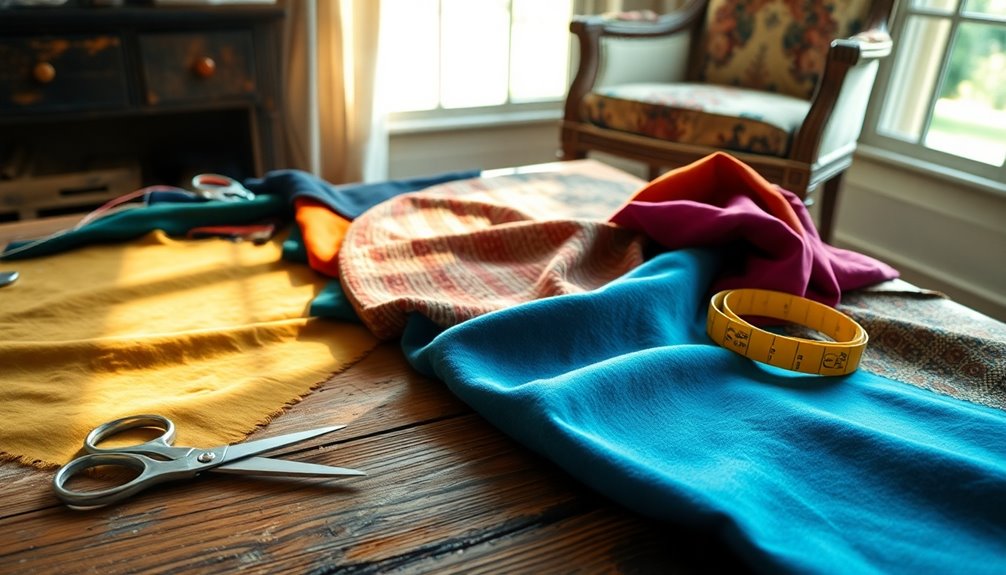
With the frame in solid shape, the next step is choosing the right fabric for your reupholstering project. Consider durability first; fabrics with a higher double rub count are more densely woven and will hold up better over time. Think about the lighting and environment where the furniture will be used—fabrics like cotton and acrylic are easy to maintain and clean, making them great choices for high-traffic areas. Additionally, selecting fabrics that complement your decor style can enhance your overall unique atmosphere in the space.
When you select the fabric, consider its intended use. For example, wool offers durability and insulation, while linen is breathable but may wrinkle. If you're after a luxurious look, velvet can elevate your furniture, but it might require blending with other fibers for added durability. Additionally, understanding fabric characteristics is essential to ensure satisfaction with your final choice.
Don't forget about color and pattern. Choose shades that complement your space and ensure that patterns are straight and correctly oriented. Texture plays a significant role too; plush fabrics can add warmth to a room. Lastly, think about dual-purpose options like those from Liberty's collection, which offer versatility for different styles. Make your fabric choice wisely to ensure both aesthetics and functionality.
Cutting the Fabric
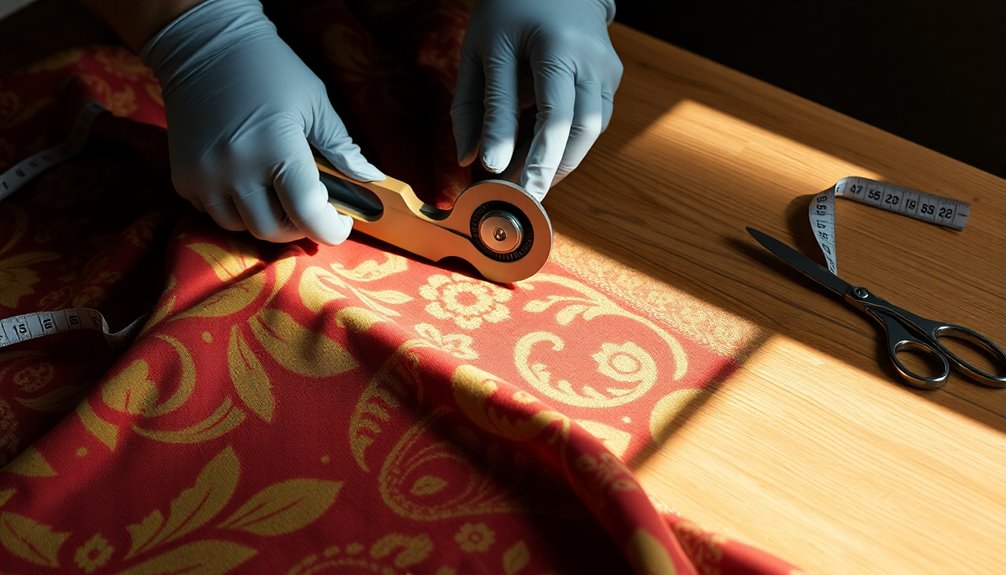
Cutting the fabric is a crucial step in your reupholstering project, as precision determines the final look and fit of your furniture. Begin by ensuring your fabric is square and free from creases. Lay it out on a large, flat surface, like a table or the floor. Use a metal square or straight edge to mark a straight line along the selvage edge. Before cutting, wash or dry clean the fabric according to the manufacturer's instructions to avoid shrinkage.
Next, create a layout chart and cutting list to ensure you have all necessary pieces. Remember to measure twice and cut once. Use original fabric pieces as patterns, tracing them onto the new fabric with chalk. When marking, add a ½ inch margin for easier stapling. Pattern matching is essential to ensure that your fabric aligns correctly across different sections of the furniture.
As you cut, label each piece with sticky notes to avoid confusion later. Avoid flipping pieces to maintain color consistency, and be mindful of patterns—match them carefully for a seamless look. If using bias strips for welt cord, cut those on the diagonal for better flexibility. Take extra care with delicate fabrics, ensuring you cut in the right direction for texture consistency.
Upholstering the Furniture
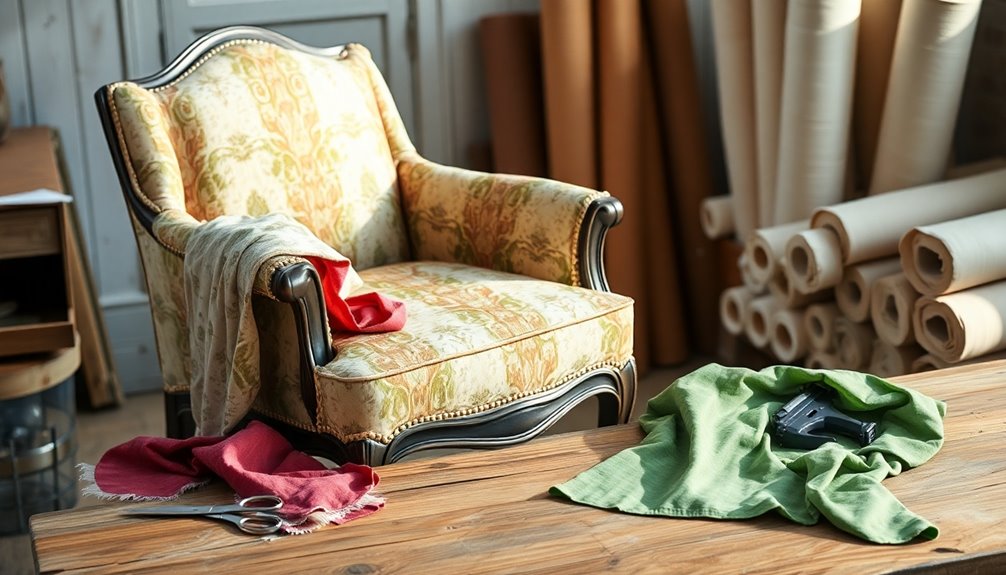
After you've meticulously cut the fabric, it's time to move on to upholstering the furniture. First, assess the frame to ensure it's sturdy. If you notice any weak spots, repair or replace them before attaching the new upholstery. This will give your furniture a solid foundation. Upholstery craftsmanship requires skill and attention to detail, which will greatly enhance the final outcome.
Using a staple gun, start attaching the fabric to one edge of the frame and work across. Pull the fabric taut as you staple to prevent wrinkles and sagging. Trim any excess fabric but leave enough for a clean finish. Make sure the staples are hidden for a polished look.
Next, inspect the old padding. If it's worn out, replace it with foam or polyurethane padding, cutting it to match the original shape. Align the new padding on the frame and secure it with staples or adhesive. For added support, consider adding webbing or springs.
Finally, enhance the appearance by adding decorative elements like welt cord or buttons. Secure any complex designs with high-temp adhesive and ensure all seams and edges are neat. With these steps, you're well on your way to giving your furniture a fresh, new look!
Securing Edges and Corners
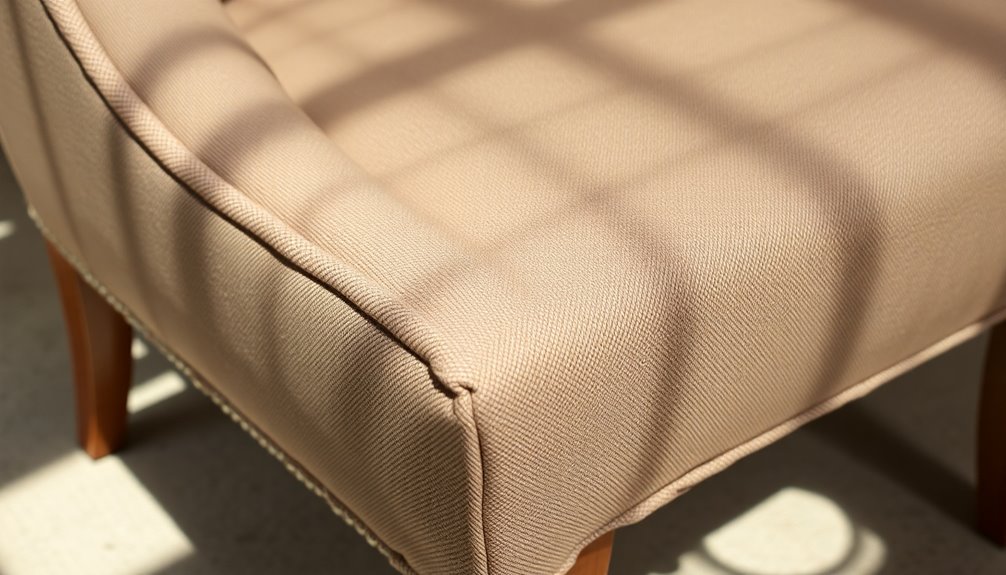
Securing edges and corners is crucial for achieving a polished look in your upholstery project. Start by measuring the straight edge you'll be upholstering and cut a piece of cardboard tack strip to size. Lay your fabric, reverse-side up, over the edge, leaving an inch or two of excess underneath. Push the tack strip into the seam's edge and attach it with tack pins or staples. Fold back the fabric to create a clean, fray-free edge, ensuring everything is tight and even.
For corners, staple around the material, stopping about two inches from each corner. Fold the fabric like you're wrapping a present for neat, symmetrical corners. Alternatively, pinch the excess fabric upwards to create a 45-degree "sail" at the corner and staple it down. Bring the fabric together in the corner and staple along both sides at a 45-degree angle. Leave an inch without staples near the outer edge. Trim the fabric close to the staples, then pull the flap tight and staple it down. Finally, check that all corners are tidy and the fabric is evenly pulled for a professional finish. Using thicker fabrics and leathers can enhance the overall success of your upholstery project.
Finishing Touches
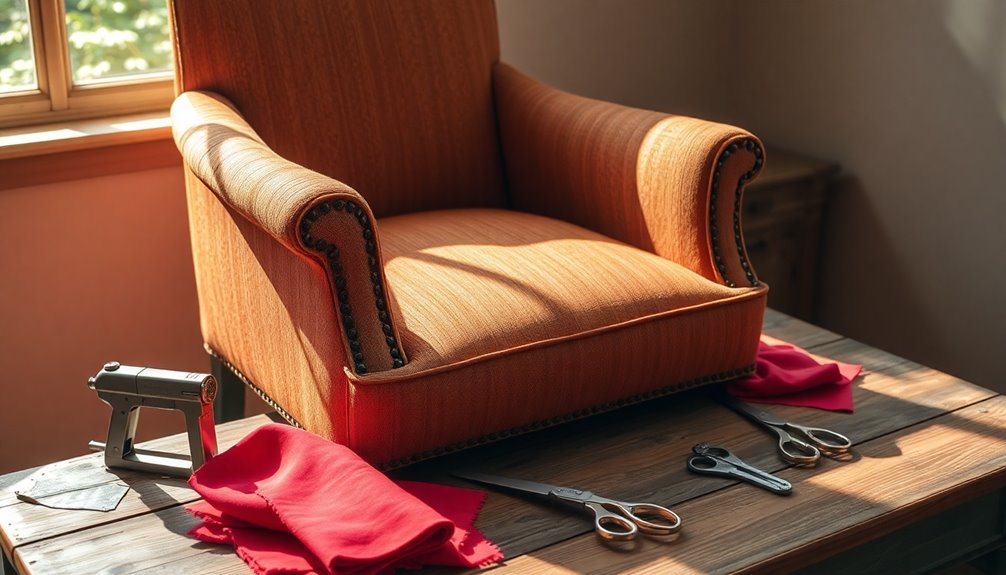
With the edges and corners of your upholstery looking sharp, it's time to enhance the overall appearance with finishing touches. Consider adding trims like gimp braids, nail heads, or tufting to give your piece unique flair. Choose trims that harmonize in color with your upholstery to maintain a cohesive look. Use tacks, nails, or a hot glue gun to attach your trims, starting in inconspicuous areas to ensure a neat finish.
Incorporate decorative details such as fabric-covered buttons or decorative tacks with unique finishes like gemstones for added personality. Expert advice on incorporating these details can help you achieve the best results. Edge roll can also provide comfort while enhancing the furniture's aesthetic. Be sure to keep decorative details aligned symmetrically for a professional appearance.
Don't forget to protect the underside of your furniture. Attach black fabric to shield it from dust and give it a polished look. Cut the new fabric using the old piece as a guide, folding over the edges before stapling securely in place.
Lastly, choose fabrics that reflect your personal style and consider the piece's functionality. Ensure that patterns align at seams to keep everything looking professional. These finishing touches will elevate your reupholstered furniture beautifully.
Final Inspection
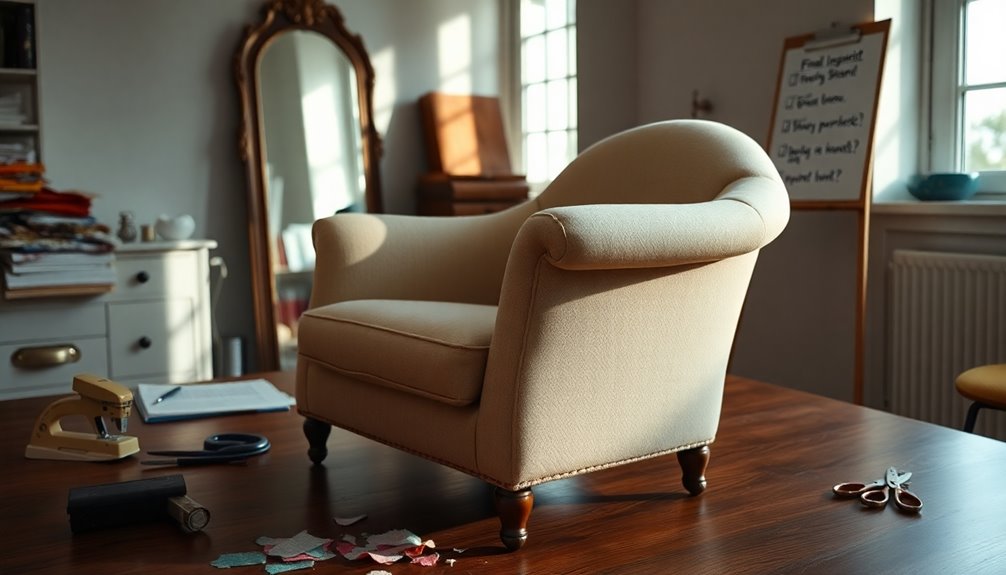
Before you finalize your reupholstered furniture, a thorough inspection is essential to ensure quality and safety. Start by checking the materials and construction. Look at the type of wood for knots, warping, and any damage. Assess the upholstery for fabric quality, stitching, and finish. Inspect metal components for rust or sharp edges, and make sure the frame and joints are sturdy and secure.
Next, perform structural stability tests. Ensure your furniture doesn't tip over on a 10-degree incline and can support the intended weight. Apply 75 lbs. of force to each leg and perform a drop impact test for durability. Additionally, it's crucial to perform a stability test to confirm that your furniture can withstand real-life usage scenarios.
Don't forget about safety and compliance. Verify that safety mechanisms work, and check edges and corners for protection against injury. Conduct a static loading test with 300 lbs. for one hour to ensure no deformation occurs.
Lastly, perform quality control by randomly sampling products, testing functionality, and checking surface quality. Conduct carton drop tests to confirm packaging integrity. By completing this final inspection, you'll ensure your reupholstered furniture is both safe and ready for use.
Frequently Asked Questions
How Much Does It Typically Cost to Reupholster Furniture?
When you're considering reupholstering furniture, you'll typically find costs around $650, but they can range from $300 to $2,000, depending on the piece. Sofas usually cost between $1,000 and $4,600, while dining chairs might only be $200 to $400. Factors like size, fabric type, and labor can influence the final price. Keep in mind that luxury pieces can exceed $10,000, so it's wise to budget accordingly.
Can I Reupholster Furniture Without Prior Experience?
You can definitely tackle reupholstering furniture without prior experience. Start with simpler projects like chairs or ottomans to build your confidence. Gather the right tools and materials, and follow step-by-step guides. Patience is key; take your time measuring and cutting fabric. Don't hesitate to seek help or watch tutorials online. You'll learn as you go, and soon enough, you'll have stunning pieces that reflect your personal style!
What Tools Do I Need for Reupholstering Furniture?
To tackle your project, you'll need essential tools like needle-nose pliers for removing staples and a staple remover for old fabric. A heavy-duty stapler or staple gun will help you attach new materials securely. Don't forget cutting tools like sewing scissors and a utility knife for precision. A rubber mallet can protect your furniture while you work. Lastly, protective gear like gloves and a dust mask will keep you safe during the process.
How Long Does the Reupholstering Process Take?
The time it takes to complete a project can vary significantly based on the size and condition of the piece. For instance, removing old fabric from a chair might take you around 8-10 hours, while a sofa could require 16-22 hours. Once you start, you'll also need to factor in the time for repairs, preparation, and reassembly, which can add several more hours to your timeline. So, patience is key!
Where Can I Find Suitable Upholstery Fabric?
You can find suitable upholstery fabric at local fabric stores, home improvement centers, or specialty upholstery shops. Online retailers like Etsy, Amazon, or dedicated fabric websites offer a vast selection too. If you're looking for something unique, check out thrift stores or antique shops. Don't forget to consider your project's specific needs, like durability and style, to ensure you choose the right fabric that fits your vision perfectly.
Conclusion
You've successfully transformed your furniture! By evaluating, disassembling, and repairing it, you laid a solid foundation. Choosing the right fabric and cutting it precisely ensured a perfect fit. As you upholstered and secured edges, you brought your vision to life. With those finishing touches, your piece is now ready to shine in your space. Take a moment to admire your hard work—you've not only revived a piece of furniture but also added a personal touch to your home!
